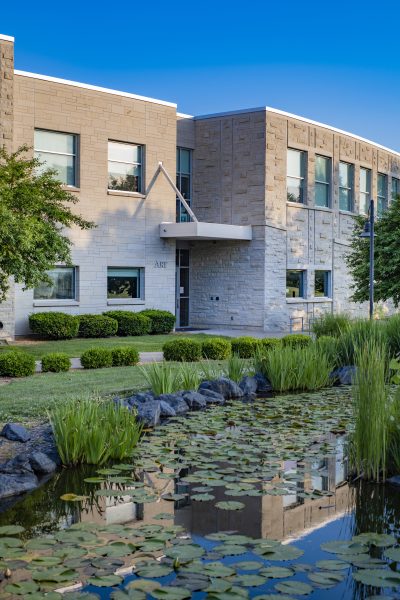
Tucked away in a calm pocket of space south of Yager Stadium is the Leland Harvey Garden, commonly referred to as the Koi Pond. Home to dozens of Kansas wildlife, the garden serves as a zen sanctuary for the Washburn community since 2006.
Leland Harvey Garden was gifted to the campus by siblings Robert Harvey and Sarah Harvey in honor of their late brother Leland Harvey. The three siblings graduated from Washburn University.
The Japanese-style garden was designed to help students, faculty and staff slow down, reflect and relax on campus. The water is lined with plenty of vegetation and obsidian mined from Colorado. With its calm waters, teeming wildlife, and gorgeous landscape, the garden could be considered one of the most peaceful spaces on Washburn’s campus.
Beneath its serenity, the garden hosts a diverse ecosystem that is larger than it seems despite its relatively small size.
The most common animals that one will notice when observing the pond are the koi fish, feeder fish, turtles, frogs and birds. Less commonly seen animals in the garden include rabbits, foxes, raccoons, possums and field mice.
Plant life is just as diverse with vegetation in every corner of the garden. Examples of plants include reeds, tall grasses, narrowleaf cattails, hardy canna lilies, American white lilies, yellow flag irises, lily pads and various other flowers.
In the winter, when temperatures drop to below freezing, the wildlife lives on. Fish that are in the water aren’t affected by the cold since only the top few layers of water freeze. The rest of the water underneath still circulates, allowing aquatic animals to survive even when the water freezes over.
Benjamin Reed, assistant professor of biology, explains how some animals survive during freezing temperatures.
“Turtles, for example, have basically antifreeze in their blood that prevents their cells from bursting in cold conditions,” Reed said. “Koi have something similar. They don’t have that [antifreeze] but they just remain active. They can remain active throughout near freezing temps by moving around and that keeps their blood flowing.”
When visiting the garden, visitors should be sure to avoid interfering with the garden wildlife to keep the ecosystem healthy. While people may like to feed the animals, Reed highly advises against this.

“People like to feed them bread. Bread is not something they can metabolize well,” Reed said. “The problem is, the animals feel full by eating it, but they get no nutrition from it.”
Students of Washburn University can visit this space to immerse themselves in the garden’s beauty. One student who visits frequently is Isabella Coria, a senior environmental biology major. Coria enjoys the pond’s calm environment.
“I really like the koi pond. I think it’s really pretty. I like studying here. I like to sit on the rocks and take some notes and stuff,” Coria said.
While admiring the landscape, Coria noticed that the pond was overgrown with vegetation; especially lily pads.
“If you don’t pay attention to things, it’s going to get overgrown,” Coria said. “The water levels are lower than they should be and we definitely have a giant lily pad infestation.”
As Kansas transitions into the colder seasons, the plants in the garden will start to die. With temperatures dropping during the fall, now may not be a good time to judge the beauty of the pond.
“We’re going into the fall. That’s part of the issue is it looks beautiful in the summer when no one’s here to look at it,” Reed said. “We’re definitely reaching the tail end of the vegetation out there. All the lily pads will die as it freezes over the winter and there will be new ones in the spring.”
Ichabods can expect the garden to flourish later in the spring.
“You’ll probably start to see good growth and green April through maybe mid-August,” Reed said.
The two most important aspects of maintaining the Leland Harvey Garden are keeping plants trimmed and making sure that the pond’s water pumps are not blocked by debris. Eric Moss, director of facilities, shares his knowledge of the effort it takes to keep the garden in good condition.
“There are electrical pumps that run all year round. We have to make sure those are running and that access to the pumps is not blocked with debris,” Moss said.
Overgrowth is one of the biggest challenges that Washburn groundskeepers have when it comes to taking care of the garden.
“The plant material grows very quickly. You combine sunlight and water and it’s the perfect scenario for plants to grow so they need to be trimmed a lot,” Moss said. “We try to trim it about three times during the summer. But that’s a big job so it takes probably two or three days to get it trimmed.”
As a peaceful spot on campus, the Leland Harvey Garden sets itself apart from other campus landmarks. While autumn may not be the best season to admire the garden, Ichabods can expect its beauty to return in the spring.
In the meantime, the pond can still serve as a space for people to slow down, reflect and relax.
Edited by Jayme Thompson and LeSha’ Davis











